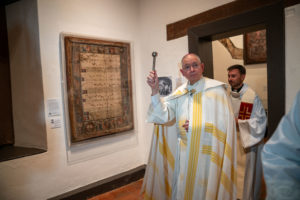Grand reopenings don’t always happen all at once.
In the case of Mission San Gabriel Arcángel, which was nearly destroyed in a July 2020 arson fire, its reintroduction to the public has happened gradually, carefully, in stages.
First, there was the closing of the mission’s 250th anniversary Jubilee Year in September 2022, when the restored adobe church opened its doors for a single Mass celebrated by Archbishop José H. Gomez — only to close them again so that artisans could complete delicate restoration work on the church’s interior.
This past Easter, celebration of Sunday Mass resumed, even while scaffolding covered the church’s restored altarpiece, the crown jewel of the historic church.
Finally, on June 27, the scaffolding came down and the renovated church was ready for its first official closeup. More than 100 people — a mix of parishioners, members of the Gabrieliño-Tongva tribe, benefactors, and staff involved in the restoration project — were on hand to witness Archbishop Gomez bless the church’s new interior, as well as a transformed mission museum.

“It’s beautiful,” said parishioner Mary Acuña Garcia, 71. “It looks like a brand new church.”
Acuña’s ties to the mission run deep. Having lived in the city of San Gabriel all her life, she was baptized in its church and got married there, just as her parents did. She has served in all kinds of ministries at the parish over the years. She and other parishioners at the Tuesday afternoon event were impressed by how the restoration seemed to bring the best out of the old and the new.
“It amazes me how everything can be refurbished and brought back to the original thing that was done,” Acuña said.
The most visible example was the church’s restored altarpiece (also commonly known as the “reredos” or “retablo”) featuring statues of the Blessed Virgin Mary, and Sts. Gabriel the Archangel, Joachim, Dominic, Anthony of Padua, and Francis of Assisi. Even before it narrowly escaped destruction in the 2020 fire, the altarpiece needed restoration work. Long hours of investigation by artisans and historians into what the original 19th century “reredos” looked like served as the basis for the color scheme used in the renovation.
“There wasn’t enough historical data to know exactly how the ‘retablo’ was done,” said project manager Jill Short of the Archdiocese of Los Angeles’ construction department. “So we took the historical data we had and tried as best we could to stay faithful to the original.”
Short oversaw a team of artisans and historians that included Enzo Selvaggi, the Orange County-based creative director of Heritage Liturgical, a sacred art and architecture firm. She credits him with helping pull off the delicate balancing act.
“You want to embrace the tradition, but you also have to be cognizant that we’re in the 2020s,” said Short. “It needs to have elements that speak to us today.”
After Archbishop Gomez blessed the altarpiece, the ceremony moved outside, where tribal chief Anthony Morales led members of the Gabrieleño San Gabriel Band of Mission Indians in singing traditional welcome songs, while remembering the approximately 6,000 Gabrieleño-Tongva natives buried on mission grounds.
Then it was time to see the mission’s museum, a “reimagined” version of its pre-fire predecessor featuring interactive displays, artwork from the mission era, readings from the letters of St. Junípero Serra, and maps detailing the tribal history of the Los Angeles Basin and its transformation following the arrival of the first Spanish missionaries and settlers.

Steven Hackel, a historian at UC Riverside and a well-known expert on the mission period in Southern California, worked as curator of the museum alongside Gabrieleño Tongva tribal member, Yve Chavez.
In remarks at the outdoor ceremony, Hackel said the museum sought to “put a new emphasis on Native experiences in the mission through 1900,” combining “visuals and sounds and interactives to suggest the varieties of Catholic experience at the mission and the persistence of Native belief and practice within an expanding Spanish and Mexican realm.”
Several pieces in the collection are accompanied by scannable QR codes that direct viewers with smartphones to historical audio recordings, including a rare one of the Our Father recited in the Gabrieleño language.
One of the most striking features is a wall displaying the names of more than 7,000 natives whose names were recorded in baptismal records through 1848, along with the years of their birth and death, when possible.
At least a few of them are ancestors of Adela Garcia, a Gabrieleño tribe member who grew up coming to the mission with her family. She said seeing the restored mission “brings me happiness” after seeing it nearly destroyed three years ago.
“There is going to be a lot of healing here,” said Garcia.
For pastor Father John Molyneux, CMF, the mission’s official reopening on July 1 — the feast day of St. Junípero, who founded San Gabriel — was the culmination of a long journey marked by unexpected delays and seemingly miraculous surprises. Longer, at least, than he had envisioned while picking up the rubble three summers ago.
“I didn't realize that this process was going to take three years,” confessed the Claretian priest.
Still, Molyneux said he and parish staff have seen God’s hand at work through all the challenges.
“I always talk about crisis and opportunity,” said Molyneux. “And I think that’s why for me this turned out to be the greatest opportunity.”

